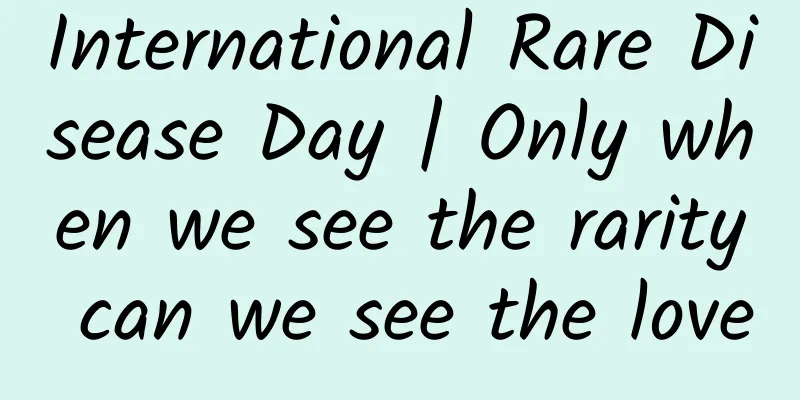International Rare Disease Day | Only when we see the rarity can we see the love

|
The last day of February every year is International Rare Disease Day. Why is this day chosen? Because February always has fewer days than other months, which is different from other months. Especially February 29, which only appears once every four years. It is like rare diseases, rare but real. As the name suggests, rare diseases refer to those diseases with extremely low incidence and very small number of patients. The "China Rare Disease Definition Research Report 2021" proposes that a disease that meets one of the three conditions of "neonatal incidence rate less than 1/10,000, prevalence rate less than 1/10,000, and number of patients less than 140,000" is a rare disease. If we only understand rare diseases from a probability perspective, we will underestimate their significant impact on society and individuals. There are more than 7,000 known rare diseases worldwide, with more than 350 million patients. In China, there are about 20 million patients with rare diseases. They live in this society just like us, but people don't pay much attention to them. For example, we may have heard of dreamy names such as "ALS", "porcelain doll", "angel man", "butterfly baby", "moon child" in news reports, all of which are related to rare diseases. Behind these beautiful names are the serious threats that rare diseases pose to life and health. "Lou Gestational Sclerosis" is a neurodegenerative disease. Patients with this disease gradually lose their body's motor functions, as if they were "frozen" and eventually die of respiratory failure. The average survival period is only 3 to 5 years. "Porcelain dolls" is a nickname for children with osteogenesis imperfecta. This disease makes the patient's bones as brittle as porcelain. A slight collision can lead to fractures. In severe cases, scoliosis and chest collapse may occur. The beautiful porcelain dolls have a shiny surface, but they may break at any time. Those children who are called "angels" suffer from Angelman syndrome. They often smile, but behind this smile are the pain of mental retardation and epilepsy. Because of their smiles, they are called "happy puppets", but their lives are far from being as simple and happy as their smiles. These names sound like fairy tales, but the reality is extremely cruel. In fact, each rare disease is like an invisible storm, quietly brewing in the patient's life until it suddenly strikes, tearing apart the original peace and leaving irreparable scars. Most rare diseases are caused by genetic defects and usually last a lifetime. More than 70% of rare diseases are hereditary, and 50%-75% of rare diseases develop in childhood. Once a disease strikes, it often leads to a significant decline in the patient's quality of life and places a heavy psychological and economic burden on their families. The genetic causes of rare diseases are irreversible, but we can still reduce their occurrence through effective preventive measures. my country has adopted a three-level prevention strategy to reduce the occurrence of rare diseases from the source. However, the diagnosis of rare diseases often takes many years, and one-quarter of patients have to wait 5 to 30 years before being diagnosed. This not only affects the lives of patients, but also leads to serious consequences such as misdiagnosis and delayed treatment. Diagnosis is not easy, and the treatment of rare diseases is also full of challenges. Due to the small number of patients and lack of research data, the development cost of drugs for rare diseases is high and progress is slow. These drugs for rare diseases are therefore called "orphan drugs". Only less than 10% of patients with rare diseases in the world have received targeted treatment, and clear treatment plans only exist for 5% of rare diseases. At the same time, the high price of drugs also makes many families reluctant to buy them. Fortunately, in recent years, the world has gradually increased its attention and investment in rare diseases. In 1983, the United States enacted the Orphan Drug Act to encourage the research and development of drugs for rare diseases through legal means. Since then, thousands of orphan drugs have been approved worldwide. China is also making continuous efforts to actively promote the development and marketing of drugs for rare diseases. In 2018, the "First Batch of Rare Diseases Catalogue" was released, and in 2023, the "Second Batch of Rare Diseases Catalogue" was further launched, covering a total of 207 rare diseases. These catalogues not only broaden the types of rare diseases, but also further increase the attention of patients with rare diseases. As of 2024, more than 80 rare disease treatment drugs have been included in the national medical insurance drug list. These developments have brought new hope to patients with rare diseases and also indicate that the country's support for the field of rare diseases is increasing. Rare diseases are indeed rare, but the equal right to life of patients should not be ignored. Through continuous education, scientific prevention, and the attention and support of the whole society, we believe that we can reduce the occurrence of rare diseases and better improve the quality of life of patients, making rare diseases "not invisible" and making social care visible. Sources [1] Chen Fang, Li Heng, Tian Xiaohang. Caring for more than 20 million patients with rare diseases[N]. Xinhua Daily Telegraph, 2022-11-08(005). [2] Make rare diseases visible earlier. China Science Popularization Network. [EB/OL]. February 29, 2024. http://www.kepu.gov.cn/news/2024-02/29/content_1744644.html [3] Focus Interview: Let the Rare Be Seen. CCTV.com. [EB/OL]. March 14, 2024. https://news.cnr.cn/native/gd/20240314/t20240314_526626389.shtml [4] More than 80 rare disease treatment drugs have been included in the national medical insurance drug list. Chinese Government Website. [EB/OL]. February 29, 2024. https://www.gov.cn/yaowen/liebiao/202402/content_6934969.htm [5] He Xiaoyan. Do a good job in tertiary prevention to reduce the pain of rare diseases[J]. Public Health, 2024, (02): 88-89. [6]Zhu C ,Hong W ,Wang L , et al.Towards key scientific questions in the diagnosis and treatment of rare diseases: Summary from the 297th Meeting of the Shuangqing Forum[J].Zoological Research,2022,43(02):234-236. [7] Diagnosis and Treatment of Rare Diseases.PubMed.[EB/OL].2024 Apr 27.https://pubmed.ncbi.nlm.nih.gov/38731103/ This article is a work supported by the Science Popularization China Creation Cultivation Program Author: Dongdongmiao Popular Science Reviewer: Tang Qin, Director of the Science Popularization Department of the Chinese Medical Association Produced by: China Association for Science and Technology Department of Science Popularization Producer: China Science and Technology Press Co., Ltd., Beijing Zhongke Xinghe Culture Media Co., Ltd. |
<<: March is the peak season for eye diseases, prevention and treatment are essential
>>: Be careful! These habits may lead to bone loss! Learn these knowledge to keep your "hard" bones
Recommend
Detailed explanation of the symptoms of non-lactation mastitis, a must-read for women!
When it comes to mastitis, most people probably t...
How can menopausal women supplement calcium better?
Calcium supplementation has always been a topic t...
What to do if your skin becomes loose after giving birth
Many female friends become insecure about their f...
Healthy diet in winter, reducing visceral fat starts with the first breakfast, eating breakfast this way is healthy and shaping
We actually carry two different types of fat in o...
Will breastfeeding make you thin after giving birth?
Many mothers will gain weight to a certain extent...
The reason why the early pregnancy test paper is getting lighter and lighter
Early pregnancy test strips are one of the common...
How to calculate ovulation period?
During the ovulation period, women must choose si...
A healthy tongue is the same, an unhealthy tongue…
There is a saying: Happy families are all alike, ...
Can women drink seahorse wine?
Seahorses were originally animals in the deep sea...
Can I still breastfeed if I have mastitis?
What to do if you have mastitis while breastfeedi...
Can I get pregnant if I can’t detect ovulation? I didn't expect the situation to be so complicated
If you have sex when ovulation is detected, the s...
It turns out that you need to "keep warm" in the summer. Do these 5 things to avoid leaving the root of disease in autumn and winter
After the summer begins, many people will tempora...
Eating too much for a long time is more harmful to your body than you think (not just making you fat)!
People always eat too much easily, sometimes beca...
Is soft-seeded pomegranate a cooling or warming fruit? When is the best time to eat soft-seeded pomegranate?
Soft-seeded pomegranates are like agate crystals,...
How long does it take to detect pregnancy after menopause?
If a woman becomes pregnant, her body will react ...









